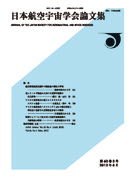
- Issue 6 Pages 213-
- Issue 5 Pages 173-
- Issue 4 Pages 133-
- Issue 3 Pages 97-
- Issue 2 Pages 57-
- Issue 1 Pages 1-
- |<
- <
- 1
- >
- >|
-
Atsushi Satoh, Masanao Watanabe, Koichi Hozumi, Akira Watanabe2020 Volume 68 Issue 2 Pages 57-64
Published: 2020
Released on J-STAGE: April 05, 2020
JOURNAL RESTRICTED ACCESSRecentry, there is a strong demand for endurance improvement of multicopters with electric propulsion system. As for the hover endurance, it mainly depends on the power consumption and the effective battery capacity in hover condition. In this work, the motor operating condition for hovering is derived from propeller characteristic and DC motor equivalent circuit model. Using these conditions, new discharge cut-off conditions which enable us to determine the proper effective capacity in hovering flight are derived. The hover endurance analysis according to the estimated effective capacity is discussed. The parametric study of hover endurance with respect to the takeoff weight and the battery weight to payload ratio is shown for a model quadcopter.
View full abstractDownload PDF (1384K) -
Kazushi Sekine, Kazunori Takagaki, Masahiro Miyashita, Takayuki Moriok ...2020 Volume 68 Issue 2 Pages 65-71
Published: 2020
Released on J-STAGE: April 05, 2020
JOURNAL RESTRICTED ACCESSIn this study, we have developed the solar array panel which generates electric power by utilizing the waste heat of the solar cell using thermoelectric generating modules to make a satellite bus higher power. In order to recover electric power efficiently by utilizing the waste heat of the panel, the relationship between the mounting area ratio of the thermoelectric generating modules and the temperature difference between the upper and lower surfaces of them was analyzed by simulation. The smaller the mounting area ratio was, the larger the temperature difference became, and the maximum specific power was obtained when it was 0.6%. Moreover, the specimen was produced with the configuration expected to maximize the output power, and the thermal vacuum test was carried out. As the result, specific power of 0.8W/m2 could be generated in the thermal environment simulating the on-orbit. It was demonstrated that output power could be recovered by utilizing waste heat of the solar array panel.
View full abstractDownload PDF (2242K) -
Kazuki Sakaki, Yoshio Nunome, Takeo Tomita2020 Volume 68 Issue 2 Pages 72-81
Published: 2020
Released on J-STAGE: April 05, 2020
JOURNAL RESTRICTED ACCESSInjection-coupled combustion instability is one of the critical issues of the rocket engine combustion. The detailed mechanism of the injection-coupled combustion instability has not been clarified yet. Recently, high-speed optical measurement techniques are frequently used to observe unsteady combustion behaviors, and modal decomposition techniques are widely used to extract dominant oscillation modes from the optical measurement results. In this study, injection-coupled combustion instability behaviors of a shear coaxial injector under a subcritical condition are observed with high-speed imaging techniques such as direct observation of flame and backlit image observation. Proper orthogonal decomposition (POD) and dynamic mode decomposition (DMD) techniques are used to extract the dominant oscillation modes. The dominant frequency of the combustion pressure and propellant injection pressures correspond to the acoustic natural frequency of the liquid oxygen post of the injector. The liquid oxygen jet deforms axisymmetrically with the observed dominant frequency. The POD and DMD analysis show that both direct images of the flame and backlit images oscillate with the observed dominant frequency, therefore, the heat release oscillation which results in the oscillation in the combustion pressure is caused by the periodic deformation of the LOX jet with the natural frequency of the LOX post.
View full abstractDownload PDF (2635K) -
Kembun Shu, Yoshiharu Tamaki, Taro Imamura2020 Volume 68 Issue 2 Pages 82-88
Published: 2020
Released on J-STAGE: April 05, 2020
JOURNAL RESTRICTED ACCESSThis paper presents the accuracy improvement of CFD analysis of turbulent flow around High-Lift Devices (HLD) using Hierarchical Cartesian Mesh, which is combined with Immersed Boundary Method, Wall Function, and Adaptive Mesh Refinement (AMR). When analyzing flow around HLD under high lift condition, the flow is deflected largely and the region away from the HLD should be also resolved sufficiently. However, Hierarchical Cartesian Mesh tends to be coarse in that region. To solve this problem, AMR based on flow field variables is introduced. First, implemented AMR method is validated, and it is shown that flow features such as shock wave or wake region can be detected automatically. Then, AMR is applied to the CFD analysis of HLD using Hierarchical Cartesian Mesh. As a result, the wake region is highly resolved, and the accuracy of the analysis especially at high angle-of-attack is improved.
View full abstractDownload PDF (3632K) -
Satoshi Ikari, Takahiro Ito, Kenshiro Oguri, Takaya Inamori, Shinichir ...2020 Volume 68 Issue 2 Pages 89-95
Published: 2020
Released on J-STAGE: April 05, 2020
JOURNAL RESTRICTED ACCESSA Fault Detection, Isolation, and Recovery (FDIR) algorithm for attitude control systems is a key technology to increasing the reliability and survivability of spacecraft. Micro/nano interplanetary spacecraft, which are rapidly evolving in recent years, also require robust FDIR algorithms. However, the implementation of FDIR algorithms to these micro/nano spacecraft is difficult because of the limitations of their resources (power, mass, cost, and so on). This paper shows a strategy of how to construct a FDIR algorithm in the limited resources, taking examples from micro deep space probe PROCYON. The strategy focuses on function redundancies and multi-layer FDIR. These ideas are integrated to suit the situation of micro/nano interplanetary spacecraft and demonstrated in orbit by the PROCYON mission. The in-orbit results are discussed in detail to emphasize the effectiveness of the FDIR algorithm.
View full abstractDownload PDF (1854K)
- |<
- <
- 1
- >
- >|